The Only Nuclear-Powered Cruise Missile US Sub
 Nuclear-powered ballistic missile submarine (1957-60), service 1960-1976 as SSGN-587
Nuclear-powered ballistic missile submarine (1957-60), service 1960-1976 as SSGN-587
Cold War US Subs
GUPPY | Barracuda class | Tang class | USS Darter | T1 class | X1 class | USS Albacore | Barbel classUSS Nautilus | USS Seawolf | Migraine class | Sailfish class | Triton class | Skate class | USS Tullibee | Skipjack class | Permit class | Sturgeon class | Los Angeles class | Seawolf class | Virginia class
Fleet Snorkel SSGs | Grayback class | USS Halibut | Georges Washington class | Ethan Allen class | Lafayette class | James Madison class | Benjamin Franklin class | Ohio class | Colombia class
USS Halibut (SSGN-587) was the one and unique nuclear-powered guided missile submarine of the US Navy, sing the Regulus system. A forerunner to later SSBNs she became later a special operations platform, and then the attack submarine SSN-587 in her long career, second ship of the name. A rare and very special boat that procured the USN its first long range deterrence patrols after the Grayback and growler, also tailored as a cruise missile submarines, but conventional. Unlike the Soviet Navy and its numerous SSGNs, the USN will only return to explore the concept of SSNs with cruise missiles with the later Batches of the Los Angeles class, but in an anti-ship role.
Design of USS Halibut
Halibut was designed under project SCB 137, a diesel-electric submarinelike the Grayback “class”, but completed instead with under SCB 137A with a nuclear reactor. She was the first USN submarine initially designed to launch guided missiles unlike the Grayback class which were a conversion. The program at the time was intended to give her the Regulus I and Regulus II nuclear cruise missiles. She had a high main deck to make for a dry “flight deck” and she had a fully automated, remotelly operated missile system using a complex hydraulic machinery. This was all controlled from a central control station which was doubled on the conning tower’s main post.
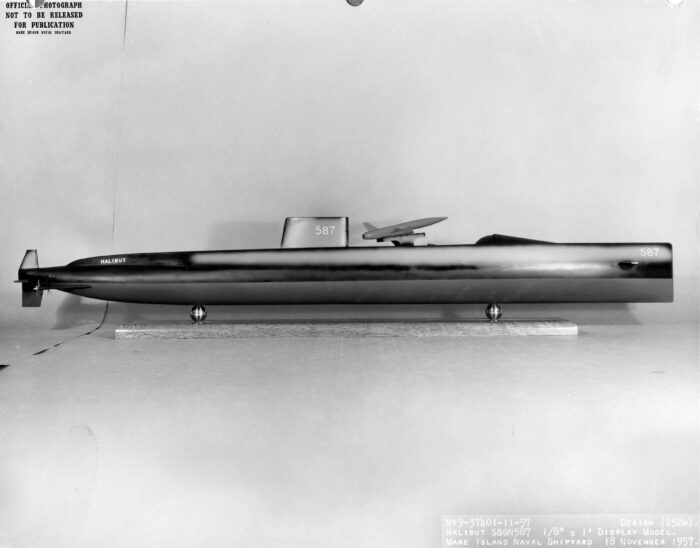
A model of the USS Halibut from navsource, ctsy of Darryl L. Baker.
She was brillant concept, but the Regulus II still obliged the carrier to close down to 1,000 nautical miles (1,852 km) from the coast to at least destroyer strategic Soviet ports. This was more about destroying the Soviet naval installations than “classic” deterrence on cities. So after completion in 1960 she was rapidly made obsolete by the Polaris Boats. Still, she had an important role, providing the first ever deterrence patrols.
Hull and general design
Halibut was a near sister to the Grayback class, with the addition of a nuclear plant. Her hull was shape was “classic”, typical of the early US submarines, pre-Albacore. Unlike the Grayback which had a prominent prow “double bulge” hosting the tubes in which the Regulus missiles were stored, and then launched from ramps on either side of the sail, she had a raised hull and an internal missile storage bay, but over deck, external launching system, which could be folded when not in use, making for a much more streamlined installation. She also had a taller, broader sail.
Much larger than the previous Gaybacks (2700-3800 tonnes), Halibut displaced 3,655 tons surfaced and 5,000 tons submerged for an overall length of 350 ft (110 m), a beam of 29 ft (8.8 m) and a draft of 28 ft (8.5 m). Ulike the Gryabacks her sail was located far more aft, leaving a large free section forward. Her stern tail and planes was also modified, and she had a pair of diving planes forward. She was also one of the latest built, the Skipjacks and Washingtons will have sail mounted diving planes.

Powerplant
The greatest difference compared to the Graybacks was her nuclear powerplant: She had the brand new S3W reactor shared by USS Skipjack. This unit, in turn, fed two turbines via a classic steam system, on two shafts. She was probably the last using a two shaft system by the way when completed in 1960. This powerplant provided 7,300 shp compared to 4600/5600 hp on the Graybacks, so making for a highr speed both surfaced (15 kts) and underwater (15.5 kts) versus 15/12 kts and unlimited autonomy but for the food carried so around 90 days for a crew of 111 versus 84 on the Graybacks. It can be argued that her automated launch system should have spared some personal but it was not the case. Her pressure hull was about the same as before and thus she felt cramped. The engineering plant was reportedly similar to that of the Skate class, with two shafts.
Armament
Torpedo Tubes
Halibut was still dependent for self protection on an array of torpedo tubes: Four forward and two aft, same model, firing the 21-inches (533 mm) standard models of the time. Compared to the previous Graybacks she lost two tubes in her pressure hull.
She carried Mk 61 torpedo tubes in the bow, and stern Mk 62 tubes. And had a total of 12 torpedoes Mark 35.
400 were Mark 35 were produced between 1949 and 1952 and were service until 1960, replaced by the Mark 37. The fire control system fed final data through a 1″ (25 mm) diameter umbilical cable cut away during tube expulsion. This was an anti-subarine torpedo first and foremost, with surface targets secondary. It could received pre-enabled run-out course/distance, search ceiling and floor data as well a right or left circling search pattern.
⚙ Mark 35 Torpedo specifications
Weight: 1,770 lbs. (803 kg)
Dimensions: 13 ft 5 in (4.089 m)
Propulsion: Electric-Battery, seawater
Range/speed setting: 15,000 yards (13,710 m)/27 knots
Warhead: 270 lbs. (122.5 kg) HBX
Guidance: Active and passive acoustic, spiral search
Initially she was to carry the Regulus I as the Graybacks, and five were stored in the single outer hull tube. This 4.5 tonnes missile capable of Mach 0.85 and 500 nm range (930 km) was however quickly superseded by the Regulus II, which had increased caracteristics across the board. See the history of the Regulus program on the Grayback article.
Regulus II
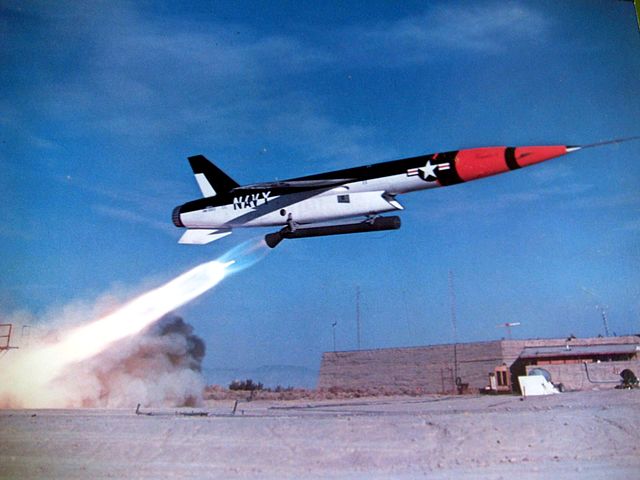
The SSM-N-9 Regulus II was deployed from USS Halibut (SSGN-587), with two stored inside the integral hangar integral built-in the hull and dependent on the same SINS (Ship’s Inertial Navigation System) to control them before launch. USS King County (AG-157) was the tests ship in 1957-58, but only registered 30% success. Production was authorized by January 1958 with, first launch by USS Grayback in September 1958.
The Regulus II was a Mach 2 missile with twice the range, better altitude and larger W27 thermonuclear payload as well as better guidance but at 1 million $ apiece and competing against the Matador. The emergence of the SLBM had the Regulus I program terminated on 19 November 1958 already, all support retired by 18 December 1958 under secretary Thomas S. Gates. Vought completed 20 missiles and then completed 27 more, albeit most ended as navy target drones for SAM tests.
The Mark 27 bomb had a yield of 1,9 kt (7,900 TJ), poduced from 1958, retired in 1964 when the Regulus II was terminated under the Kennedy administration.
The W27 warhead weighed 2,800 pounds (1,300 kg). 20 were produced for the SSM-N-9 Regulus II with a special team deployed with the crew for their care and operation and under presidential orders.
Sensors
Same suite as for the Grayback class.
BPS-12 radar: Medium-range surface search and navigation radar, modified BPS-5, similar to BPS-14, periscope antenna and conventional antenna.
BQS-4: Active/passive detection sonar, AN/BQR-2 passive detection system and added active detection capability. Chin bow dome.
BQR-2 sonars: Cylindrical (or circular) array mounted in chin dome.
WLR-1 ECM suite: No info yet.
In the late 1960s she obtained the new BQG-4 sonar and later before end of the decade, she had the BLR-1 ECM suite removed and replaced by the new WLR-1 ECM suite. This was her last upgrade.

⚙ specifications |
|
| Displacement | 3655 tons surfaced, 5000 tons submerged |
| Dimensions | 350 x 29 x 28 ft (110 x 8.8 x 8.5 m) |
| Propulsion | 2 shafts steam turbines, S3W reactor, 7,300 shp. |
| Speed | 15 knots (28 kph) surfaced, 20+ kt (37 km/h) submerged |
| Range | Unlimited except by food supplies |
| Armament | 5x Regulus I or 2x Regulus II missiles, single launcher, 6× 21 in TTs |
| Sensors | BPS-12 radar, BQS-4, BQR-2 sonars, WLR-1 ECM suite |
| Crew | 9 officers+ 88 men |
Career of USS Halibut
At first denominated SSGN587 (from 8.1965- SSN587) USS Halibut was laid down ay Mare Island N Yd, in Vallejo, California on 11 April 1957, launched on 9 January 1959 and completed on 4 January 1960. USS Halibut departed for her shakedown cruise 11 March 1960 and on the 25th while underway to Australia, she was the first nuclear-powered submarine to launch a guided missile. She was back to Mare Island shipyard on 18 June 1960 for fixes, and followed by extra training. She made another cruise to Pearl Harbor from 7 November and was assigned to the Pacific Fleet. Her first patrol saw her seventh Regulus I launch as part of a Southeast Asia Treaty Organization (SEATO) weapons demonstration. Back to Pearl Harbor on 9 April 1961, she made a second cruise on 1 May. She later took part in several missile firing exercises.
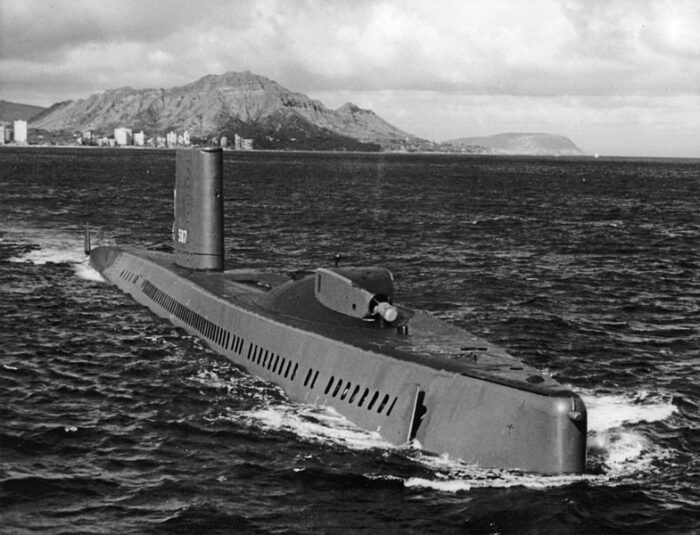
Her third patrols was in the Western Pacific by late 1961 with the Regulus II, and more until 1964. On 4 May 1964 she departed Pearl Harbor for her last Regulus missile patrol in the Pacific (The Graybacks had been retired already). She amde a total of seven deterrent patrols until replaced by Polaris Lafayette class SSBNs. On September-December 1964 she was used to test attack capabilities of the new Permit-class submarines.
All this time her primary target in case of war would have been the Soviet naval base at Petropavlovsk-Kamchatsky.
Operation Sand Dollar (1965) With supervision of John P. Craven, US Naval Intelligence she competed for the role of bottom exploration and exploration with USS Seawolf for conversion on a limited budget, preffering not to commission a new and purpose-built submarine. USS Halibut was chosen and under a $70 million in February 1965 was to be festooned with electronic, sonic, photographic, and video systems. She was conveted in Pearl Harbor Naval Shipyard, in her career’s major overhaul completed on 15 August reclassed as SSN-587.
Se then started a new cycle of special operations until 1976.
She departed Pearl Harbor on 6 September for the West Coast, Keyport, Washington (20 September) to received extra equipments and on 5 October she departed back to Pearl Harbor after another stop at Mare Island, and arrived 21 October.
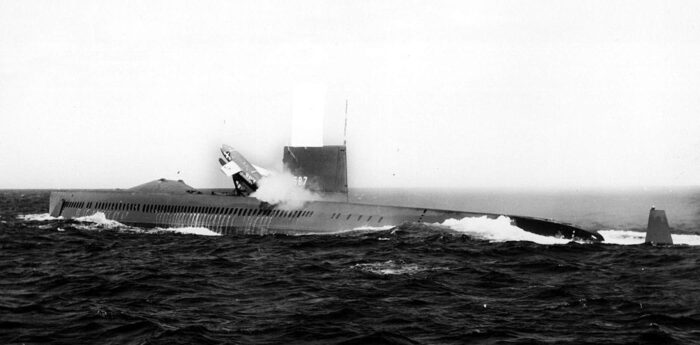
She started ASW operations until August 1968 and was transferred to Mare Island for overhaul and installation of side thrusters as well as a hangar section sea lock and anchoring winches, fore and aft mushroom anchors to be soldly planted on the bedrock. She had a saturation diving habitat using mixed gas as well as a long and short range side-look sonar and a video and photographic equipment. She saw the installation of a massive Sperry UNIVAC 1224 mainframe computer (a first on any submlarine) plus tapping and recording equipment located port and starboard. She also had fore and aft seabed skids or “sneakers” and a towed underwater search vehicle (“fish”) forward, plus an extra winch and specialized oceanographic equipment. She was back to Pearl Harbor in 1970 and was reassigned to the Pacific Fleet, Submarine Development Group One (SubDevGruOne) based at the Support Facility San Diego (Now Naval Base Point Loma/Ballast Point) with offices at Mare Island.
She was used in yealry underwater espionage missions on the Soviet Union until her decommission in 1976.
One of her best “feat” was the underwater tapping of a Soviet communication line in the Kamchatka peninsula connected to the mainland, in the Sea of Okhotsk, Operation Ivy Bells.
She also made a full survey of the wreck of K-129 on the seabed by August 1968, and dave the greelight for CIA’s Project Azorian.
USS Halibut was decommissioned on 30 June 1976 and mothballed at Keyport/Bangor Trident Base in Washington until stricken from the Naval Vessel Register on 30 April 1986. As a nuclear boat she went through the Ship-Submarine Recycling Program at Puget Sound Naval at Bremerton in Washington, on 9 September 1994.
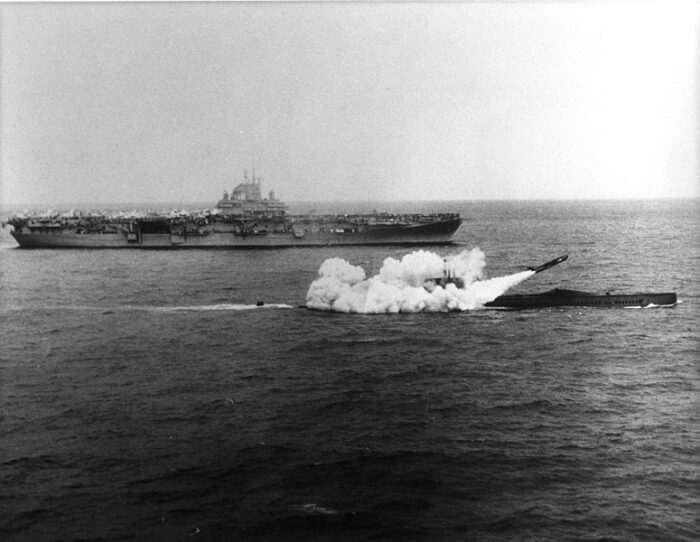
Read More/Src
Books
Conway’s all the world’s fighting ships 1947-95 page 610
Links
aboutsubs.com halibut.htm
navsource.org/
history.navy.mil/
usni.org/
navypedia.org/
nationalinterest.org/ uss-halibut
en.wikipedia.org USS_Halibut SSGN-587
hullnumber.com SSN-587
navalorder.org/ operation-ivy-bells
hisutton.com uss Halibut.html
hisutton.com/ Halibut Cutaway.html
Videos
Model Kits
A bunch of old kits, see there

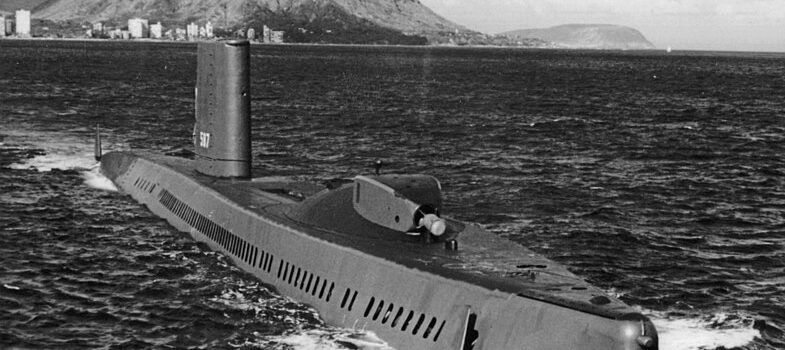
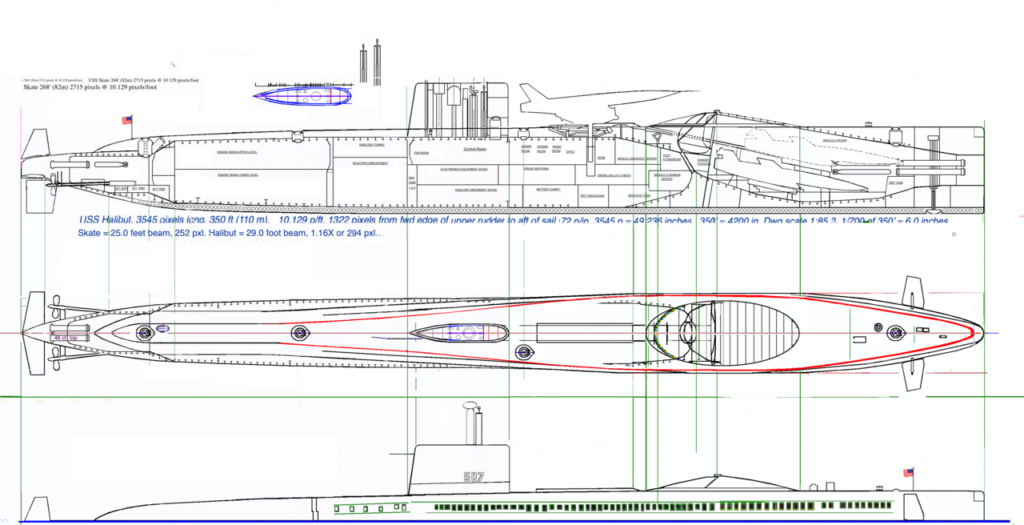
 Latest Facebook Entry -
Latest Facebook Entry -  X(Tweeter) Naval Encyclopedia's deck archive
X(Tweeter) Naval Encyclopedia's deck archive Instagram (@navalencyc)
Instagram (@navalencyc)





 French Navy
French Navy Royal Navy
Royal Navy Russian Navy
Russian Navy Armada Espanola
Armada Espanola Austrian Navy
Austrian Navy K.u.K. Kriegsmarine
K.u.K. Kriegsmarine Dansk Marine
Dansk Marine Nautiko Hellenon
Nautiko Hellenon Koninklije Marine 1870
Koninklije Marine 1870 Marinha do Brasil
Marinha do Brasil Osmanlı Donanması
Osmanlı Donanması Marina Do Peru
Marina Do Peru Marinha do Portugal
Marinha do Portugal Regia Marina 1870
Regia Marina 1870 Nihhon Kaigun 1870
Nihhon Kaigun 1870 Preußische Marine 1870
Preußische Marine 1870 Russkiy Flot 1870
Russkiy Flot 1870 Svenska marinen
Svenska marinen Søværnet
Søværnet Union Navy
Union Navy Confederate Navy
Confederate Navy Armada de Argentina
Armada de Argentina Imperial Chinese Navy
Imperial Chinese Navy Marinha do Portugal
Marinha do Portugal Mexico
Mexico Kaiserliche Marine
Kaiserliche Marine 1898 US Navy
1898 US Navy Sovietskiy Flot
Sovietskiy Flot Royal Canadian Navy
Royal Canadian Navy Royal Australian Navy
Royal Australian Navy RNZN Fleet
RNZN Fleet Chinese Navy 1937
Chinese Navy 1937 Kriegsmarine
Kriegsmarine Chilean Navy
Chilean Navy Danish Navy
Danish Navy Finnish Navy
Finnish Navy Hellenic Navy
Hellenic Navy Polish Navy
Polish Navy Romanian Navy
Romanian Navy Turkish Navy
Turkish Navy Royal Yugoslav Navy
Royal Yugoslav Navy Royal Thai Navy
Royal Thai Navy Minor Navies
Minor Navies Albania
Albania Austria
Austria Belgium
Belgium Columbia
Columbia Costa Rica
Costa Rica Cuba
Cuba Czechoslovakia
Czechoslovakia Dominican Republic
Dominican Republic Haiti
Haiti Hungary
Hungary Honduras
Honduras Estonia
Estonia Iceland
Iceland Eire
Eire Equador
Equador Iran
Iran Iraq
Iraq Latvia
Latvia Liberia
Liberia Lithuania
Lithuania Mandchukuo
Mandchukuo Morocco
Morocco Nicaragua
Nicaragua Persia
Persia San Salvador
San Salvador Sarawak
Sarawak Uruguay
Uruguay Venezuela
Venezuela Zanzibar
Zanzibar Warsaw Pact Navies
Warsaw Pact Navies Bulgaria
Bulgaria Hungary
Hungary

 Bundesmarine
Bundesmarine Dutch Navy
Dutch Navy Hellenic Navy
Hellenic Navy Marina Militare
Marina Militare Yugoslav Navy
Yugoslav Navy Chinese Navy
Chinese Navy Indian Navy
Indian Navy Indonesian Navy
Indonesian Navy JMSDF
JMSDF North Korean Navy
North Korean Navy Pakistani Navy
Pakistani Navy Philippines Navy
Philippines Navy ROKN
ROKN Rep. of Singapore Navy
Rep. of Singapore Navy Taiwanese Navy
Taiwanese Navy IDF Navy
IDF Navy Saudi Navy
Saudi Navy Royal New Zealand Navy
Royal New Zealand Navy Egyptian Navy
Egyptian Navy South African Navy
South African Navy






























 Ukrainian Navy
Ukrainian Navy dbodesign
dbodesign